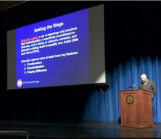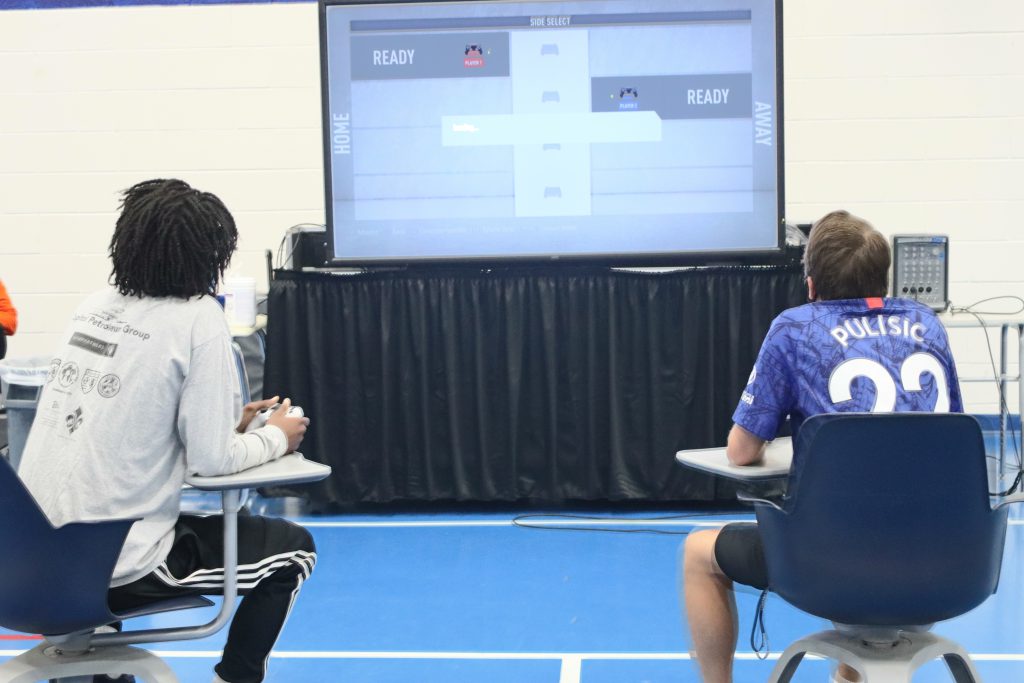Diversity is an uncomfortable subject in all aspects. Many students do not know how to deal with diversity and do not even know when it is actually happening. The only way to learn more about diversity and ways to deal with it is by having that conversation.
On Wednesday, Feb. 26, students gathered in the Joan & Macon Brock Theatre in the Susan S. Goode Fine and Performing Arts Center at 7 p.m. to further their understanding of diversity. James Thomas, associate professor of sociology at the University of Mississippi, spoke to VWU students and faculty with his “When Diversity is Everywhere, It’s Nowhere?” lecture, which was part of the On Deck speaker series. Students also gathered in the Susan S. Goode Fine and Performing Arts Center, Joan & Macon Brock Theatre at 11 a.m. for a “Coalitions for Change on College Campuses” lecture, where he provided ways to effectively talk about diversity on college campuses.
Thomas’s research primarily focuses on race, and racism, inequality and empire. He is the author of four books, including the forthcoming “Diversity Regimes,” which draws from his ethnographic fieldwork at an American public university. His research examines conflicts in regards to defining, organizing and implementing diversity within institutions.
His aim for this lecture is for people to think critically about the aspects of diversity. “The central point of my project is that despite the best intentions of many actors around the table, diversity is a matter of practice that often obscures, entrenches and even intensifies racial inequality on college campuses,” Thomas said. He referred to this central point as a diversity regime. This “diversity regime” consists of a set of meanings and practices that institutionalizes the superficial commitment to diversity and then ultimately fails to make any real structural changes in how power, resources, opportunities and decision making are distributed across the institution.
As he returned to the University of Mississippi for his second semester, Thomas’s interest in diversity began. Faculty and staff emphasized the importance of diversity by celebrating the 50-year anniversary of integration on campus. During this time, Barack Obama was elected president for a second term. White students on campus produced and posted racially-insensitive Tweets. About 400 students, primarily white, gathered at The Grove, a lawn for students on campus. Black student bystanders were taunted with racial slurs as the white students chanted, “The South shall rise again,” Thomas said.
He began to think about how and why this could be happening, especially at a campus that was so heavily focusing on the 50-year anniversary of its integration. Thomas believes it is worth considering to what extent racism on a college campus, from daily microaggressions to overt racial violence, is enabled by the campus, the way it is organized and how it functions. He recognizes that college campuses are now more numerically diverse than ever, but there is a glaring contradiction between diversity’s ideal and its empirical reality. The wrong questions are being asked. In order to effectively talk about diversity, campuses must direct the focus toward diversity’s processes which means taking a close look at how diversity is being defined, organized and put into practice.
Thomas strongly believes condensation disassociates diversity from racial inequality. He defined condensation as the process through which any number of unrelated elements are condensed under a single sign. Diversity serves as a general idea for all possible differences including, geographical differences, political differences and even differences in dexterity. This broad view of diversity was the matter of active negotiation among participants in Thomas’ research. These conversations started off by stating the campus needs racial inclusivity among safe spaces. This quickly escalated to students stating that if those groups of people can have a safe space then students who are from out of state need a safe space as well.
Senior Colin Jones believes that racial inequality is seen everywhere, not just on college campuses. “Promoting and celebrating all races on campus is extremely important to gain racial inclusivity,” Jones said. Senior Emma Walsh also believes that diversity should be talked about. “Yes, it is good to talk about diversity and racial inclusivity, but what is being done about it in order to make a change?” Walsh asked.
In many cases, colleges represent their diversity by the number of minorities that attend their institution. How is this idea of diversity and racial inclusion implemented on all campuses? Senior Corin Jackson believes that racial inclusivity is lacking in the faculty. “I think in terms of the student body we are pretty diverse and I feel included. Our real fault comes from our lack of diversity within our faculty,” Jackson said. “In my four years here, I have only had two professors of color, which is something I think the school should pay attention to.”
Karleigh Warren
kawarren1@vwu.edu


